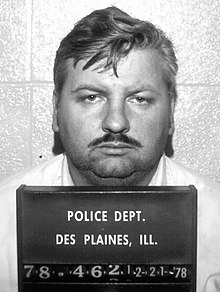When discussing notorious serial killers, John Wayne Gacy stands out among the most infamous. Known as the “Killer Clown,” Gacy was responsible for the murders of at least 33 young men and boys in the 1970s. As his time came to its tragic end, Gacy’s last meal became a topic of curiosity, revealing glimpses into the man behind the grotesque crimes.
Before his execution by lethal injection on May 10, 1994, Gacy requested a final meal to mark his last moments. In a seemingly ordinary selection, Gacy asked for fried shrimp, a bucket of original recipe KFC chicken, French fries, strawberries, and a Diet Coke. It’s worth noting that Gacy was once the manager of three KFC restaurants, which may have influenced his choice.
While it might be tempting to make assumptions about Gacy’s character based on his last meal, it’s important to avoid drawing conclusions without context. Instead, consider these details as one small piece of a much larger story relating to this menacing figure’s life and the devastation he left behind.
John Wayne Gacy: The Man behind the Monster
Let’s delve into the chilling story of John Wayne Gacy, a serial killer who terrorized the Chicago area during the 1970s. We’ll explore his haunting past, murderous exploits, and the tragic last moments leading up to his execution.
Born in Chicago in 1942, Gacy endured a troubled childhood filled with physical and emotional abuse from his father. In the early 1970s, he established himself as a well-liked community member, even dressing up as Pogo the Clown for children’s parties. However, beneath this façade of normalcy, Gacy harbored dark, sinister secrets.

Between 1972 and 1978, Gacy committed heinous crimes that earned him the disturbing nickname, “The Killer Clown.” He lured young boys to his home with the promise of work, only to sexually assault, torture, and murder them. In total, Gacy brutally took the lives of 33 victims.
A table with the most notorious crimes attributed to Gacy:
| Year | Victim | Age | Crime Scene |
|---|---|---|---|
| 1972 | Tim McCoy | 16 | Gacy’s home |
| 1976 | John Szyc | 19 | Gacy’s home |
| 1977 | Robert Gilroy | 18 | Gacy’s home |
| 1978 | Robert Piest | 15 | Gacy’s home |
Some chilling details of Gacy’s horrific crimes include:
- Victims were typically strangled or suffocated with ropes or plastic bags
- Gacy usually buried the corpses in the crawlspace under his home or dumped the bodies in nearby rivers
- His final known crime, the murder of Robert Piest, led police to uncover his trail of bloodshed
Gacy’s trial commenced in February 1980, and he was found guilty of 33 counts of murder. Ultimately, he received 21 life sentences and 12 death sentences.
While his heinous crimes are certainly terrifying, it’s equally important for us to understand Gacy’s mindset leading up to his last meal. As you continue reading about John Wayne Gacy’s last meal, we encourage you to reflect on his haunting past and how it contributed to the monster he became. Reminiscing on these chilling events underscores our commitment to keeping alive the memory of the victims, their families, and the chilling case that shook the nation.
Gacy’s Final Days on Death Row
In the final days of his life, John Wayne Gacy found himself on death row for the brutal murders of 33 young men and boys. As one of America’s most notorious serial killers, many were waiting for the day when Gacy would face his ultimate fate.
During his time on death row, Gacy took to painting as a means to cope with his grim reality. He created numerous works, some of which even featured his infamous clown persona, “Pogo the Clown.” We must note that these paintings have been met with significant controversy, with some believing they shouldn’t be displayed or sold because of their dark connections.
In spite of his reprehensible actions, Gacy attempted to maintain a semblance of normalcy in his final days. He went through the usual routines and interactions, but it was impossible to forget the monstrous acts he had committed. As his execution date loomed closer, Gacy’s demeanor began to shift.
May 9, 1994 was set as the date for Gacy’s execution by lethal injection, and the countdown began. He spent his remaining days in his cell, awaiting the justice that would be served to him for a string of heinous crimes.
We mustn’t leave out the topic of Gacy’s last meal, as it’s a point of discussion that captivates many true crime enthusiasts. Here’s a breakdown of what he requested for his final meal:
| Items | Size |
|---|---|
| Fried Chicken | 1 Bucket |
| French Fries | 1 Large Order |
| Fried Shrimp | 12 Pieces |
| Fresh Strawberries | 1 Bowl |
| Diet Coke | 1 Can |
It’s been reported that he enjoyed his last meal on May 9, 1994 before being escorted to the execution chamber.
John Wayne Gacy’s final moments were filled with a mix of anticipation and dread, but as the clock ticked down, there was no escape from the end he had brought upon himself. With a somber stillness in the air, Gacy was put to death via lethal injection at 12:58 AM on May 10, 1994.
Gacy’s dark legacy continues to be a topic of fascination, horror, and debate. His final days on death row serve as a reminder of the unimaginable acts he committed and the justice delivered to a man who became synonymous with pure evil.
Last Meal Requests: A Tradition in American Criminal Justice
Last meal requests hold a particular fascination for those who are intrigued by the American criminal justice system. We’ll delve into its origins and explore its role in the culture surrounding high-profile cases like that of John Wayne Gacy.
The tradition originated in ancient civilizations, including Greece and Rome, where individuals sentenced to death were offered a final meal as a form of compassionate gesture. In the United States, the practice continues in many states, granting the inmate a sense of dignity and comfort as they approach the end of their life.
There are a few noteworthy last meal requests throughout history. Here are some of the most memorable ones:
- Victor Feguer: Last federal execution prior to the 2001 reinstatement of the death penalty, requested a single unsalted olive with the pit still in it.
- Ted Bundy: Infamous serial killer declined a special meal, so he was served the standard prison fare of steak, eggs, hash browns, toast, milk, coffee, and juice.
- John Wayne Gacy: The focus of this article, requested a meal of fried chicken, French fries, a pound of strawberries, and a Diet Coke.
While every prisoner’s last meal varies, there are some common trends among the dishes chosen. For instance, most condemned individuals often request:
- Fast food: Popular chain restaurants, such as KFC or McDonald’s, are frequently requested.
- Comfort food: Items like fried chicken or pizza typically make their way onto the menu.
- Desserts: Sweet treats, including ice cream and cake, are often part of the last meal.
Despite the historical roots of this tradition, some states in the U.S. have decided to abolish the practice of granting special last meal requests. For example, Texas ended the custom in 2011 after an offender named Lawrence Brewer ordered an extravagant meal but then did not eat any of it. Other states still choose to continue the practice to offer a small humanizing gesture in an otherwise bleak situation.
In conclusion, the last meal request serves as a reminder of the complexities and peculiarities surrounding the subject of capital punishment in America. Our look at this tradition only adds to the mystique of cold cases, providing readers with intriguing details and a more complete understanding of the criminal justice system’s inner workings.
Dissecting Gacy’s Last Meal Choices
John Wayne Gacy, also known as the “Killer Clown”, was a notorious American serial killer responsible for the murders of at least 33 young men and boys in the 1970s. As a death row inmate, Gacy was allowed to choose his last meal, for which he opted for a selection of his favorite foods. So what exactly did he choose, and what do these choices reveal about him as a person?
Gacy’s last meal request included:
- Fried shrimp
- A bucket of KFC original recipe chicken
- French fries
- A pound of strawberries
It’s interesting to note that Gacy chose KFC chicken as part of his last meal, as he had actually been a manager for the fast food chain prior to his criminal career. This might suggest a sense of nostalgia or even comfort associated with his time working there. Also, choosing a bucket of chicken could signify that he wanted to indulge in a hearty, satisfying meal before his execution.
When it comes to the fried shrimp, it could simply represent Gacy’s love for seafood or a particular fondness for fried foods. Although there may be no deeper meaning behind this choice, it does showcase his preference for flavorful, decadent dishes.
The inclusion of french fries highlights Gacy’s affinity for familiar, comforting, and crowd-pleasing meals. This choice might reveal that, at his core, Gacy still craved the simple pleasures in life.
Lastly, the pound of strawberries reflects Gacy’s desire for a touch of sweetness and freshness to balance out the meal’s heavy flavors. As strawberries are often associated with indulgence and luxury, this choice could also hint at Gacy’s appreciation for finer experiences and flavors.
| Choice | Possible Reason |
|---|---|
| KFC Chicken | Nostalgia and comfort |
| Fried Shrimp | Love for seafood |
| French Fries | Craving for comfort food |
| Strawberries | Desire for sweetness and luxury |
While we can’t draw definitive conclusions about Gacy’s character from his last meal choices, they do offer a glimpse into his culinary preferences and the type of experiences he valued. These selections and their possible meanings add another layer to our understanding of one of America’s most infamous serial killers.
Conclusion: The Legacy of John Wayne Gacy
We’ve delved into various aspects of John Wayne Gacy’s life, including his notorious criminal activity and last meal. As we wrap up our discussion, it’s essential to reflect on the lasting impact of Gacy and what his life and crimes teach us.
Gacy’s legacy is a testimony to the unparalleled darkness that can reside within a person. Despite appearing as an upstanding member of society, he harbored a monstrous secret that ultimately led to the brutal deaths of 33 young men and boys. His case serves as a chilling reminder to always be vigilant and cautious about the people in our lives.
Additionally, Gacy’s case significantly influenced the field of criminal psychology and law enforcement. His actions and unprecedented crime spree prompted experts to further study the behavior and motivations of serial killers, improving our understanding of these heinous individuals.
- Advancements in criminal profiling
- Development of new investigative techniques
- More informed approaches to prevent and solve similar cases
John Wayne Gacy will forever be remembered as one of America’s most infamous and brutal serial killers. His story evokes fear, fascination, and an enduring sense of loss that continues to captivate our collective imagination. As true-crime enthusiasts, we’re compelled to continue learning from the past, delving into cold cases and dissecting the nuanced details of these tragic events.
At MurderArchives.org, we’re committed to keeping the memory alive and providing a platform for exploring the chilling world of crime and mystery. Join us in our quest for understanding, and together, we’ll journey through the darkest corners of human history.

Owner & entrepreneur with a passion for murder mystery! Seriously, who doesn’t love murder mystery?
Chris is a proud member of the American Medical Writer’s Association (AMWA), the International Society for Medical Publication Professionals (ISMPP), the National Association of Science Writers (NASW), the Council of Science Editors, the Author’s Guild, and the Editorial Freelance Association (EFA).

